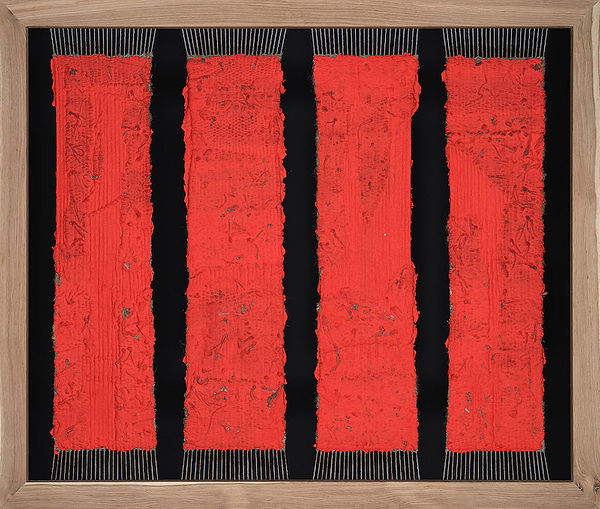
YULIA NESIS
ART OF TAPESTRY
SELECTED WORKS

IN THE COLLECTION OF
ACCADEMIA ARTI DEL DISEGNO
FIRENZE, ITALY

"Terra Flammea"
110 X 130
FLAX, HEMP, NAILS, WOOD, TAPESTRY
2012


BACK SIDE


TERRA FLAMMEA, meaning "earth engulfed in flames." This is how the theologian Hilary of Poitiers translates the name of the first person who lived on earth - Adam.
In Hebrew, the name Adam shares its root with the Hebrew words אדמה (adamah) - "earth" and אדום (adom) - "red." Attempting to penetrate its inherent meaning, Hilary thus seeks to understand the essence and purpose of human existence. Why did the Lord name the first human Adam?
For is this suffering blood-red flesh not truly engulfed in flames? Does this earth not burn with desires and passions? Why is human life inseparable from pain and suffering, and why does the mortal body seem to burn up in life's fire?
T A P E S T R Y A R T

"Lithophyte"
HANDMADE TAPESTRY
2025
A tree that has taken root among the rocks. A plant that has found its own ecological niche here. A miracle of evolutionary adaptability. Here one can witness the motif of desperate struggle for existence, life’s ability to adapt to any adverse circumstances and put down roots where no life could possibly exist.
Applied to humanity, this might appear an overly obvious metaphor. An Austrian psychologist Viktor Frankl, who found the strength to survive a Nazi concentration camp within himself, wrote:
“WHEN WE ARE NO LONGER ABLE TO CHANGE
A SITUATION, WE ARE CHALLENGED TO
CHANGE OURSELVES”
However, the work “Lithophyte” is not only about this, but also about the special bond that emerges between tree and stone. This is a connection between the living and the lifeless, the flexible and the rigid, the young and the ancient.
OPPOSITES NEED EACH OTHER,
COMPLEMENT EACH OTHER,
AND CANNOT EXIST WITHOUT ONE ANOTHER
How would we know that stone is hard, were it not for the tree’s flexibility? How would we understand youth and transience, were it not for ancient rocks that have existed for millions of years?
And yet the tree and stone form a unified whole. The rock gradually crumbles and becomes soil, becoming both support for the tree and the very substance of this tree. The tree becomes an extension of the stone, its roots penetrating ever deeper into the crevices of the rock face. Without this stone, the tree cannot live.
Sometimes such interconnectedness is called love.